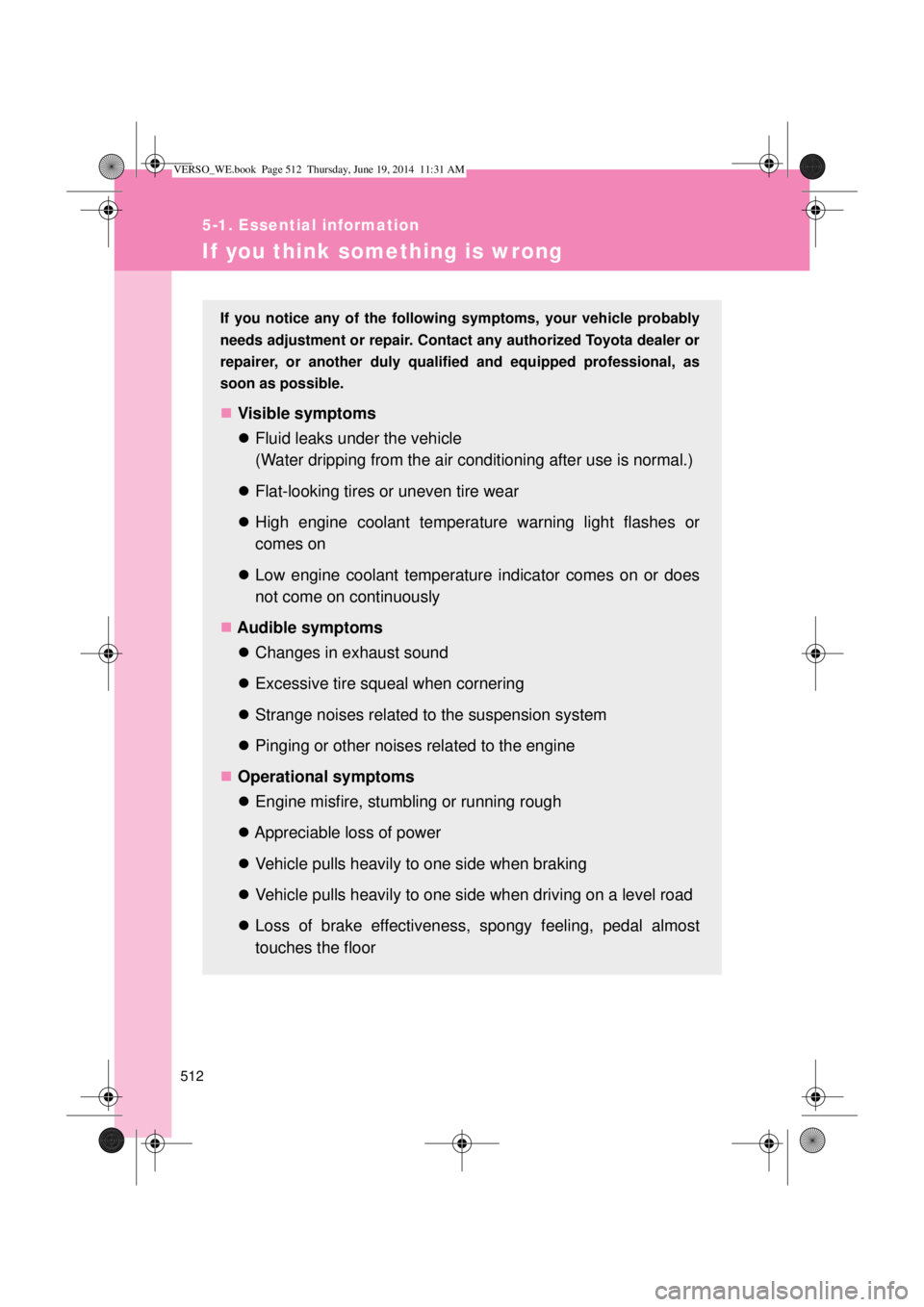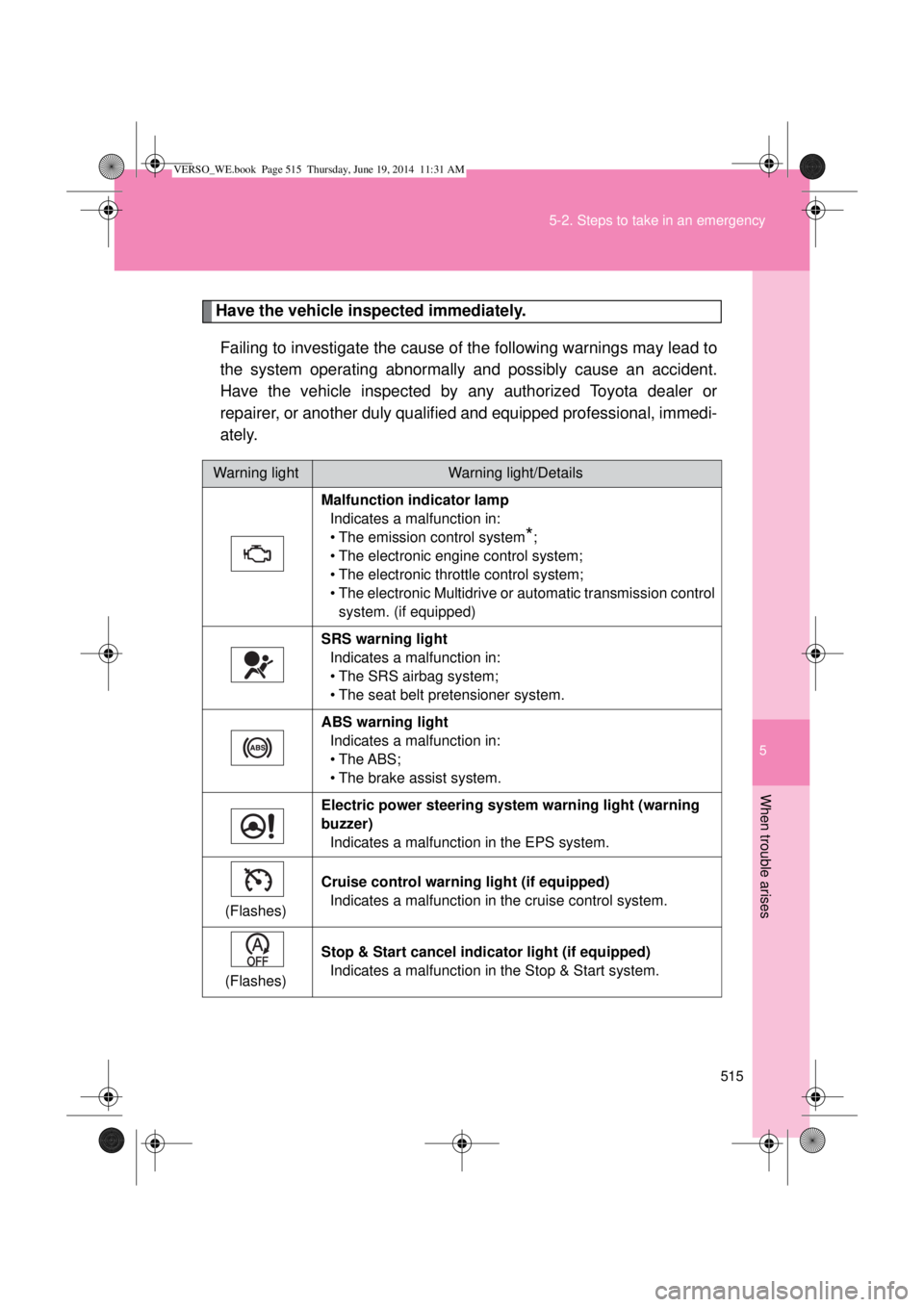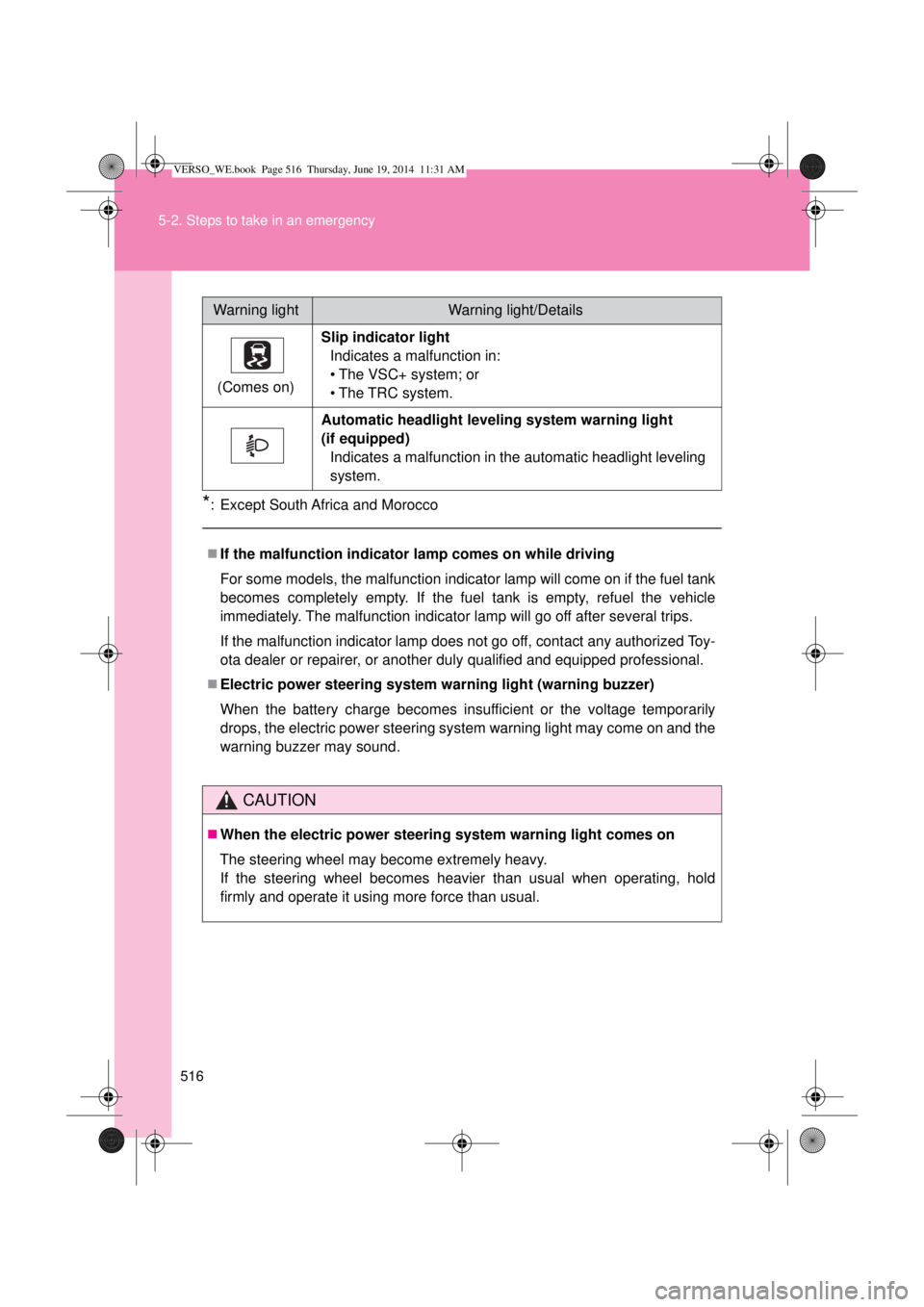Page 512 of 650

512
5-1. Essential information
If you think something is wrong
If you notice any of the following symptoms, your vehicle probably
needs adjustment or repair. Contact any authorized Toyota dealer or
repairer, or another duly qualified and equipped professional, as
soon as possible.
Visible symptoms
Fluid leaks under the vehicle
(Water dripping from the air conditioning after use is normal.)
Flat-looking tires or uneven tire wear
High engine coolant temperature warning light flashes or
comes on
Low engine coolant temperature indicator comes on or does
not come on continuously
Audible symptoms
Changes in exhaust sound
Excessive tire squeal when cornering
Strange noises related to the suspension system
Pinging or other noises related to the engine
Operational symptoms
Engine misfire, stumbling or running rough
Appreciable loss of power
Vehicle pulls heavily to one side when braking
Vehicle pulls heavily to one side when driving on a level road
Loss of brake effectiveness, spongy feeling, pedal almost
touches the floor
VERSO_WE.book Page 512 Thursday, June 19, 2014 11:31 AM
Page 515 of 650

5
515 5-2. Steps to take in an emergency
When trouble arises
Have the vehicle inspected immediately.
Failing to investigate the cause of the following warnings may lead to
the system operating abnormally and possibly cause an accident.
Have the vehicle inspected by any authorized Toyota dealer or
repairer, or another duly qualified and equipped professional, immedi-
ately.
Warning lightWarning light/Details
Malfunction indicator lamp
Indicates a malfunction in:
• The emission control system
*;
• The electronic engine control system;
• The electronic throttle control system;
• The electronic Multidrive or automatic transmission control
system. (if equipped)
SRS warning light
Indicates a malfunction in:
• The SRS airbag system;
• The seat belt pretensioner system.
ABS warning light
Indicates a malfunction in:
• The ABS;
• The brake assist system.
Electric power steering system warning light (warning
buzzer)
Indicates a malfunction in the EPS system.
(Flashes)Cruise control warning light (if equipped)
Indicates a malfunction in the cruise control system.
(Flashes)Stop & Start cancel indicator light (if equipped)
Indicates a malfunction in the Stop & Start system.
VERSO_WE.book Page 515 Thursday, June 19, 2014 11:31 AM
Page 516 of 650

516 5-2. Steps to take in an emergency
*: Except South Africa and Morocco
(Comes on)Slip indicator light
Indicates a malfunction in:
• The VSC+ system; or
• The TRC system.
Automatic headlight leveling system warning light
(if equipped)
Indicates a malfunction in the automatic headlight leveling
system.
If the malfunction indicator lamp comes on while driving
For some models, the malfunction indicator lamp will come on if the fuel tank
becomes completely empty. If the fuel tank is empty, refuel the vehicle
immediately. The malfunction indicator lamp will go off after several trips.
If the malfunction indicator lamp does not go off, contact any authorized Toy-
ota dealer or repairer, or another duly qualified and equipped professional.
Electric power steering system warning light (warning buzzer)
When the battery charge becomes insufficient or the voltage temporarily
drops, the electric power steering system warning light may come on and the
warning buzzer may sound.
CAUTION
When the electric power steering system warning light comes on
The steering wheel may become extremely heavy.
If the steering wheel becomes heavier than usual when operating, hold
firmly and operate it using more force than usual.
Warning lightWarning light/Details
VERSO_WE.book Page 516 Thursday, June 19, 2014 11:31 AM
Page 533 of 650
5
533 5-2. Steps to take in an emergency
When trouble arises
Once
*1
(Flashes)Indicates that
the electronic
key does not
operate prop-
erly.Press the
“ENGINE
START STOP”
switch while
applying the
brakes.
Once
*2
(Flashes)Indicates that
the electronic
key does not
operate prop-
erly.Press the
“ENGINE
START STOP”
switch while
applying the
clutch pedal.
Once
*1
(Flashes)Indicates that
the shift lever
out of “P” or “N”
and turned to
the “ENGINE
START STOP”
switch off.Turn the
“ENGINE
START STOP”
switch off to
after shift the
shift lever to “P”.
Indicates that
the auto power
off function.Start the
engine.
Increase the
engine speed
slightly and
maintain at that
level for approx-
imately 5 min-
utes to recharge
the battery of
your vehicle.
Interior
buzzerExterior
buzzerWarning messageDetailsCorrection
procedure
VERSO_WE.book Page 533 Thursday, June 19, 2014 11:31 AM
Page 556 of 650
556 5-2. Steps to take in an emergency
Before performing emergency repair
Check the degree of the tire
damage.
• Do not remove the nail or
screw from the tire. Removing
the object may widen the
opening and prevent emer-
gency repair with the repair kit.
• Type A: To avoid sealant leak-
age, move the vehicle until the
area of the puncture, if known,
is positioned at the top of the
tire.
Type B
Power plug
Compressor switch
Air pressure gauge
HoseNozzle
Stickers
Pressure release
button
VERSO_WE.book Page 556 Thursday, June 19, 2014 11:31 AM
Page 560 of 650
560 5-2. Steps to take in an emergency
Remove the injection hose from
the valve and screw the valve
core in the valve securely by
turning it clockwise with the
valve core tool.
Connect the air compressor
hose by threading it on the valve.
Connect the compressor power
plug to the power outlet socket.
(P. 381)
Vehicles without smart entry &
start system: The engine switch
must be in the “ACC” position.
Vehicles with smart entry & start
system: The “ENGINE START
STOP” switch must be in ACCES-
SORY mode.
Valve core
Valve
core tool
CompressorHose
VERSO_WE.book Page 560 Thursday, June 19, 2014 11:31 AM
Page 562 of 650
562 5-2. Steps to take in an emergency
Turn the switch off when the pressure gauge connected to the
hose reads the specified pressure.
If the inflation pressure is not attained within 5 minutes, emergency
repair is not possible due to severe damage. Contact any authorized
Toyota dealer or repairer, or another duly qualified and equipped pro-
fessional.
After completely filling the tire with air, disconnect the hose
from the valve on the tire.
Pull the power plug of the compressor out of the power outlet
on the vehicle.
To spread the liquid sealant evenly in the tire, immediately
drive for about 5 km (3 miles) or 10 minutes.
After driving about 5 km (3 miles)
or 10 minutes, pull your vehicle
over in a safe place and recon-
nect the compressor.
Read the inflation pressure on
the pressure gauge.
VERSO_WE.book Page 562 Thursday, June 19, 2014 11:31 AM
Page 566 of 650
566 5-2. Steps to take in an emergency
Connect the bottle to the com-
pressor.
Screw the end of the nozzle
clockwise as far as possible.
Make sure that the compressor
switch is off.
Remove the power plug from the
compressor.
Connect the power plug to the
power outlet socket. (P. 381)
VERSO_WE.book Page 566 Thursday, June 19, 2014 11:31 AM